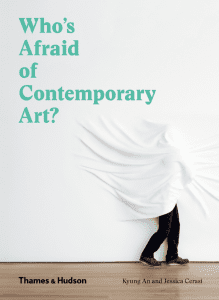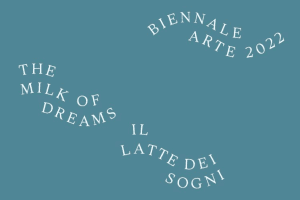Regardless of your education or experience in the art world, reading these books will bestow you with a strong grasp of contemporary artists, art values, and the dirty deeds that only underpaid curators with PhDs, auction house executives and accountants who worked on the notorious “Panama Papers” know.
I read all of these books and highly recommend them for anyone who is even remotely interested in art. Command art dialect, understand different genres, and learn to identify top artists in an instant. I dove headfirst into the deep end when it came to the art world only six years ago. Now I realize it will take a lifetime to really grasp everything. However, with these books I have been referred to read by friends with PhDs or museum curators I felt my confidence shoot up like milkweed.
Let’s start with the book I always recommend first because it is short, sweet, and written for comprehension. You can read this on your flight to Miami for Art Basel and land with the swagger of a Hauser and Wirth curator.
1. “Who’s Afraid of Contemporary Art?” by Jessica Cerasi and Kyung An
This book is nearly pocket size and can be read in about an hour to 90 minutes flat. Photo examples of each artist are included.
Summary by the authors: “Who’s Afraid of Contemporary Art brings together all you need to give you the confidence to hold your own in a conversation about contemporary art… or to go to an exhibition and decide if you like it. If we can talk about topics as complex as the latest technology, an art-house film, or the next general election casually with friends, then why does the idea of chatting about contemporary art fill us with so much fear? It is a specialist field like any other, and can lend itself to informal understanding and dinner party conversation in much the same way.”
2. “Why have there been no great women artists?” By Linda Nochlin
A shortie but a goodie, this fantastic (some would say revolutionary) look at art history, and those who determine what is ‘genius’ will have your head spinning! You may even find yourself questioning everything you thought you knew about not only art but history itself. Dare I say, it will have you reassessing your education and questioning the structure of society itself!
Take a look at the publisher’s summary here, then buy it asap. You WILL be the smartest person at the art party after reading this.
“Many scholars have called Linda Nochlin’s seminal essay on women artists the first real attempt at a feminist history of art. In her revolutionary essay, Nochlin refused to answer the question of why there had been no “great women artists” on its own corrupted terms, and instead, she dismantled the very concept of greatness, unraveling the basic assumptions that created the male-centric genius in art.
With unparalleled insight and wit, Nochlin questioned the acceptance of a white male viewpoint in art history. And future freedom, as she saw it, requires women to leap into the unknown and risk demolishing the art world’s institutions in order to rebuild them anew.”
3. “33 Artists in 3 Acts” by Sarah Thornton
This book was the first book I read in 2016 when I began peeling back the skin of the hot air balloon-sized onion that is the art market. Before this book, I didn’t understand HOW people like Jeff Koons could sell a cute dog sculpture for tens of millions of dollars, or why Yayoi Kusama was taken seriously despite her current mental condition and living in an institution. Where did she come from? How did she get started? You will learn all this and more about top contemporary artists after this auspicious book, just in time for Art Basel.

4. “Dark Side of the Boom: The Excesses Of The Art Market In The 21st Century” by Georgina Adam
Does anyone remember the Panama Papers? Want to understand a bit about WHY and HOW the art market can be so attractive to the unscrupulous elites of the world? This judicious read needs to be a movie, at least a documentary. Anyone have friends at Netflix? Help Georgina out if you do.
I’ll let the publisher explain. “This book scrutinizes the excesses and extravagances that the 21st-century explosion of the contemporary art market brought in its wake. The buying of art as an investment, temptations to forgery and fraud, tax evasion, money laundering, and pressure to produce more and more art all form part of this story, as do the upheavals in auction houses and the impact of the enhanced use of financial instruments on art transactions.
Drawing on a series of tenaciously wrought interviews with artists, collectors, lawyers, bankers, and convicted artist forgers, the author charts the voracious commodification of artists and art objects and art’s position in the clandestine puzzle of the highest echelons of global capital. Adam’s revelations appear even more timely in the wake of the Panama Papers revelations, for example incorporating examples of the way tax havens have been used to stash art transactions – and ownership – away from public scrutiny.”
5. “A History of the Western Art Market : A Sourcebook of Writings on Artists, Dealers, and Markets” by Titia Hulst
Finally, the studious Titia Hulst takes us through the emergence and evolution of the art markets in the Western world. As an asset class, fine art sits in the top three in the world right up there with real-estate and the stock market, yet little is known about how it grew to maintain this stronghold in the capitalist economic marketplace.
Her publisher notes that it is “Selected writings from across academic disciplines present compelling evidence of art’s inherent commercial dimension and show how artists, dealers, and collectors have interacted over time, from the city-states of Quattrocento Italy to the high-stakes markets of postmillennial New York and Beijing. This approach casts a startling new light on the traditional concerns of art history and aesthetics, revealing much that is provocative, profound, and occasionally even comic. This volume’s unique historical perspective makes it appropriate for use in college courses and postgraduate and professional programs, as well as for professionals working in art-related environments such as museums, galleries, and auction houses.”
Though it is regarded for professional use, I think it is appropriate for anyone who wants to better understand the financial innuendo of the fine art market. If you have any book recommendations for me please feel free to share them and I will take a look with alacrity.







